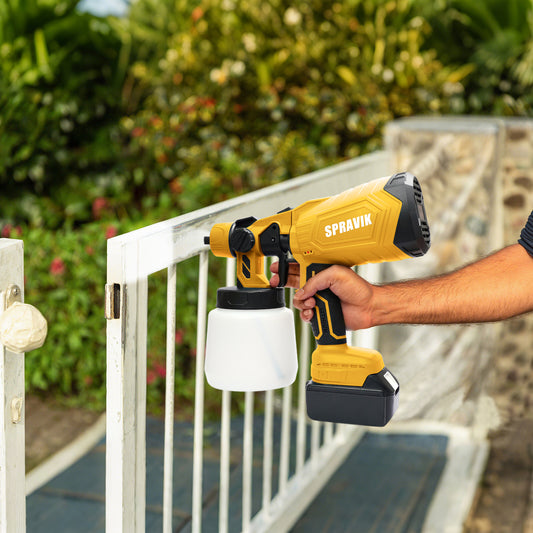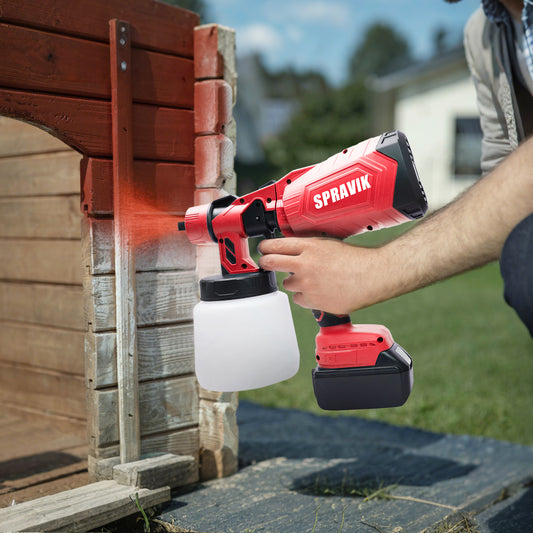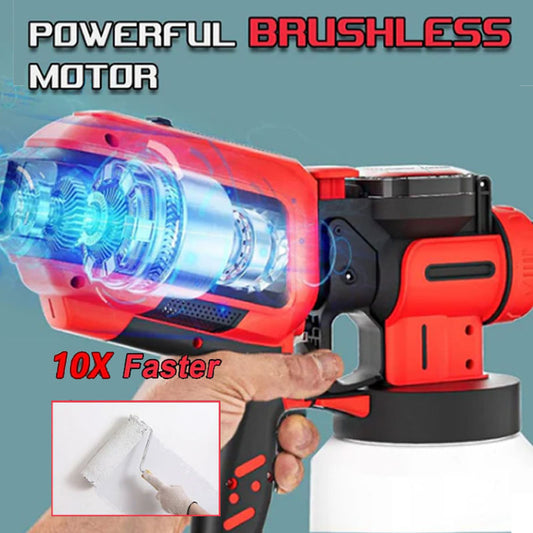
How to Repaint Furniture Like a Pro Using a Paint Sprayer
Spravik AdminRepainting furniture is one of the most rewarding DIY projects you can tackle. Whether you're giving new life to a flea market find or modernizing a hand-me-down piece, the right tools and techniques make all the difference. Using a paint sprayer transforms the repainting process, delivering a flawless, brush-free finish that’s difficult to achieve with traditional methods. In this guide, you’ll learn how to repaint furniture like a pro, with expert insights on using an air paint sprayer, a battery paint sprayer, or even choosing the best paint sprayer for home use.
Choosing the right paint sprayer is the foundation of a successful furniture makeover. There are three common types: air paint sprayers (also known as pneumatic), battery-powered paint sprayers, and electric (corded) sprayers. Each has pros and cons depending on your budget, mobility needs, and level of detail required.

An air paint sprayer uses compressed air to atomize paint into a fine mist. It’s a favorite among professional painters for its precision and control. If you’re working on detailed furniture—like chairs with spindles or cabinets with grooves—an air paint sprayer offers unmatched finesse. However, it does require an air compressor and is less portable, making it less ideal for those without a dedicated workspace.
A battery paint sprayer, on the other hand, offers incredible flexibility. These cordless models are perfect for home users without a lot of space or who want to work outdoors. The lack of cords and hoses makes them easy to maneuver around furniture, especially for pieces with multiple sides and corners. If you’re new to spraying, a battery paint sprayer is often the best paint sprayer for home use due to its simplicity and convenience.
Before you even open a can of paint, preparation is key. Begin by cleaning the furniture thoroughly to remove dirt, grease, or wax. Use a degreaser or mild soap solution and a scrub sponge. Rinse and dry completely.
Next, sand the surface to remove gloss and allow for better paint adhesion. Use medium-grit sandpaper for rough sanding and a fine-grit paper for finishing. If the piece has existing peeling paint or deep scratches, sanding is non-negotiable. Wipe away dust with a tack cloth or microfiber rag.

Primer is a must for most furniture projects, especially if you're covering dark wood with lighter paint or working with laminate. Choose a spray-compatible primer and apply a light, even coat with your sprayer. Whether you're using an air paint sprayer or a battery paint sprayer, always test your spray pattern on cardboard first to avoid drips or uneven coverage.
Once your primer dries, it's time to paint. Shake or stir your paint thoroughly, and thin it if your sprayer requires. Apply paint in light, even coats, keeping the sprayer about 10–12 inches from the surface. Overlap each pass by 30–50% for consistent coverage.
Avoid the temptation to apply too much paint at once. It’s better to do multiple thin coats than to deal with drips or pooling. Let each coat dry according to the paint manufacturer's instructions before applying the next.
For those new to spraying, battery paint sprayers are often the best paint sprayer for home use because of their ease-of-use and minimal setup. Many modern models come with adjustable spray tips and flow controls, helping you adapt to the furniture's contours and size.
Furniture pieces like dressers, side tables, and bookshelves respond particularly well to sprayer applications. Using an air paint sprayer on flat surfaces can result in a smooth, near-factory finish. When refinishing chairs or furniture with legs, a battery paint sprayer allows for better agility and less fatigue during extended spraying.
Another critical tip: paint in a dust-free, well-ventilated area. Dust particles can ruin an otherwise perfect finish. If working indoors, use a drop cloth and mask surrounding areas. If outside, avoid windy conditions.
When spraying indoors, a dedicated spray shelter or portable spray booth is highly recommended. These protect your workspace and help control overspray, especially when using an air paint sprayer, which tends to disperse finer particles.
To repaint furniture like a pro, you also need to select the right type of paint. Latex paint is great for beginner-friendly cleanup and works well on most indoor furniture. Oil-based paints offer a more durable finish but require stronger solvents for cleanup. For the best results, use paints labeled as “furniture-grade” or “spray-friendly.”
You can also consider adding a topcoat, especially for high-use items like desks or dining chairs. A clear polyurethane or polycrylic finish adds durability and protects the color. Apply using your sprayer or a high-quality brush if preferred.
After painting, allow your piece to cure properly. This is not just drying—it’s the process where the paint hardens and adheres fully to the surface. Depending on the paint type and room conditions, curing can take from several days to a week. Avoid placing heavy objects or using the furniture until it’s fully cured.
Cleaning your sprayer immediately after use is crucial. Whether you’re using an air paint sprayer or battery paint sprayer, dried paint can clog the nozzle and ruin future applications. Run a cleaning solution or water (for water-based paint) through the sprayer, disassemble any removable parts, and scrub gently with a soft brush.
Storage is another factor. Store your paint sprayer in a dry, clean area, preferably in its original case or a protective box. Battery-powered models should have their batteries removed and charged regularly to maintain performance.
When shopping for the best paint sprayer for home use, consider the following features:
Adjustable pressure and spray pattern
Easy-to-clean design
Lightweight constructionBattery life (for cordless models)
Compatibility with different paint types
Brands like Graco, Wagner, and HomeRight offer solid options for every budget level. Even if you're not a seasoned DIYer, investing in a quality sprayer can transform your painting projects.
Using a paint sprayer gives you more control over the finish, especially on furniture with curves, details, and multi-dimensional shapes. You save time, reduce waste, and elevate your final result. With the right preparation, technique, and tool—whether an air paint sprayer, battery paint sprayer, or the best paint sprayer for home use—you’ll be amazed at what you can accomplish.
In conclusion, repainting furniture is no longer a chore reserved for the pros. With a modern paint sprayer in your toolkit, you can give old furniture a stunning makeover with less effort and better results. Whether you're refinishing a nightstand, transforming a vintage hutch, or adding flair to a plain dresser, the power of a good sprayer can’t be overstated. Equip yourself with the right tools and knowledge, and you’ll be repainting like a professional in no time.










